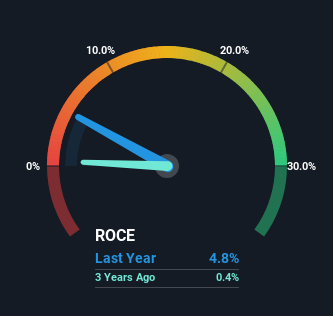If we want to find a potential multi-bagger, often there are underlying trends that can provide clues. Ideally, a business will show two trends; firstly a growing return on capital employed (ROCE) and secondly, an increasing amount of capital employed. Ultimately, this demonstrates that it's a business that is reinvesting profits at increasing rates of return. Having said that, from a first glance at Yuan Long Ping High-Tech Agriculture (SZSE:000998) we aren't jumping out of our chairs at how returns are trending, but let's have a deeper look.
What Is Return On Capital Employed (ROCE)?
If you haven't worked with ROCE before, it measures the 'return' (pre-tax profit) a company generates from capital employed in its business. Analysts use this formula to calculate it for Yuan Long Ping High-Tech Agriculture:
Return on Capital Employed = Earnings Before Interest and Tax (EBIT) ÷ (Total Assets - Current Liabilities)
 0.048 = CN¥678m ÷ (CN¥26b - CN¥12b) (Based on the trailing twelve months to September 2024).
0.048 = CN¥678m ÷ (CN¥26b - CN¥12b) (Based on the trailing twelve months to September 2024).
Thus, Yuan Long Ping High-Tech Agriculture has an ROCE of 4.8%. In absolute terms, that's a low return and it also under-performs the Food industry average of 6.8%.

In the above chart we have measured Yuan Long Ping High-Tech Agriculture's prior ROCE against its prior performance, but the future is arguably more important. If you're interested, you can view the analysts predictions in our free analyst report for Yuan Long Ping High-Tech Agriculture .
How Are Returns Trending?
The returns on capital haven't changed much for Yuan Long Ping High-Tech Agriculture in recent years. The company has employed 38% more capital in the last five years, and the returns on that capital have remained stable at 4.8%. This poor ROCE doesn't inspire confidence right now, and with the increase in capital employed, it's evident that the business isn't deploying the funds into high return investments.
Another point to note, we noticed the company has increased current liabilities over the last five years. This is intriguing because if current liabilities hadn't increased to 46% of total assets, this reported ROCE would probably be less than4.8% because total capital employed would be higher.The 4.8% ROCE could be even lower if current liabilities weren't 46% of total assets, because the the formula would show a larger base of total capital employed. So with current liabilities at such high levels, this effectively means the likes of suppliers or short-term creditors are funding a meaningful part of the business, which in some instances can bring some risks.
In Conclusion...
In conclusion, Yuan Long Ping High-Tech Agriculture has been investing more capital into the business, but returns on that capital haven't increased. And in the last five years, the stock has given away 12% so the market doesn't look too hopeful on these trends strengthening any time soon. In any case, the stock doesn't have these traits of a multi-bagger discussed above, so if that's what you're looking for, we think you'd have more luck elsewhere.
If you'd like to know more about Yuan Long Ping High-Tech Agriculture, we've spotted 2 warning signs, and 1 of them doesn't sit too well with us.
If you want to search for solid companies with great earnings, check out this free list of companies with good balance sheets and impressive returns on equity.
Have feedback on this article? Concerned about the content? Get in touch with us directly. Alternatively, email editorial-team (at) simplywallst.com.
This article by Simply Wall St is general in nature. We provide commentary based on historical data and analyst forecasts only using an unbiased methodology and our articles are not intended to be financial advice. It does not constitute a recommendation to buy or sell any stock, and does not take account of your objectives, or your financial situation. We aim to bring you long-term focused analysis driven by fundamental data. Note that our analysis may not factor in the latest price-sensitive company announcements or qualitative material. Simply Wall St has no position in any stocks mentioned.

